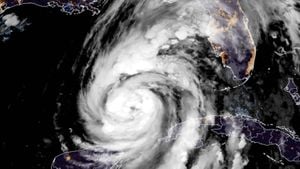Climate change is one of the most pressing issues of our time, with impacts that ripple across ecosystems, economies, and societies. A new study has shed light on an intriguing aspect of climate dynamics: the diurnally asymmetric trends in cloud cover and how they amplify global warming. This research delves into the variations in cloud cover throughout the day and night, revealing their significant role in enhancing surface warming, a phenomenon that has far-reaching implications.
Historically, scientists have observed that nighttime temperatures tend to rise faster than daytime temperatures, leading to a reduction in the diurnal temperature range. This trend, previously attributed to factors like changes in cloud cover, atmospheric humidity, and soil moisture, has now been dissected further to understand its intricate dynamics. The study utilizes data from the Coupled Model Intercomparison Project Phase 6 (CMIP6), spanning from 1970 to 2100, to analyze cloud fraction trends over the course of a day and their relationship with radiative effects.
The study employs a robust methodology, converting coordinated universal time (UTC) data into local solar time (LST) to obtain a global picture of the cloud diurnal cycle (CDC). By focusing on the regions between 60°S and 60°N, researchers identified that cloud fraction exhibits a diurnally asymmetric variation rate. Specifically, cloud fractions at 12 LST (solar noon) decrease more rapidly than at 00 LST (midnight). This finding indicates a broadening of the CDC, which is a critical factor in understanding surface temperature changes.
One of the most striking revelations of the study is the role of anthropogenic greenhouse gases (GHGs) in driving these diurnally asymmetric cloud trends. The researchers examined simulations under different forcing scenarios from the CMIP6 Detection and Attribution Model Intercomparison Project (DAMIP). They found that the GHG-forced simulation mirrored the historical diurnally asymmetric cloud fraction trend, suggesting that increased GHGs are a primary contributor. This conclusion aligns with the notion that GHGs impact lower tropospheric stability, resulting in more pronounced surface warming during nighttime.
Interestingly, the study also reveals geographical inconsistencies in diurnally asymmetric cloud fraction trends. The tropics exhibit a broadening of the CDC, driven by a more rapid decrease in cloud cover during the day compared to the night. In contrast, the subtropics show an opposite trend, with nighttime cloud cover diminishing faster, leading to a narrowing of the CDC. These regional disparities underscore the complexity of cloud-radiation interactions and their spatial variability.
Digging deeper into the mechanisms behind these trends, the researchers highlight two key factors: surface air temperature (SAT) anomalies and lower tropospheric stability. Anomalies in SAT influence cloud fraction by shifting the cloud transition region, which in turn affects radiative properties and feedbacks. Lower tropospheric stability, defined as the temperature difference between 700 hPa and the surface, plays a crucial role in determining cloud cover. A stronger inversion—higher lower tropospheric stability—efficiently traps moisture, sustaining cloudiness, particularly at night.
The implications of these findings are profound. Diurnally asymmetric cloud cover trends amplify surface warming by reducing the daytime cloud albedo effect and enhancing the nighttime greenhouse effect. In simpler terms, clouds that diminish during the day allow more sunlight to heat the surface, while clouds that persist during the night trap more outgoing longwave radiation, leading to warmer nights. This dual impact contributes significantly to the overall warming trend.
From a broader perspective, these insights are crucial for improving climate models and informing policy decisions. Understanding the role of clouds in modulating surface temperatures can help refine predictions of future climate scenarios, enabling better preparation and mitigation strategies. For instance, regional variations in cloud trends should be considered in local climate adaptation plans, especially in areas vulnerable to extreme temperature fluctuations.
Nevertheless, the study acknowledges certain limitations and areas for future research. While the analysis provides robust evidence for diurnally asymmetric cloud trends, it primarily focuses on cloud fraction, without delving into other cloud properties like height, phase, and optical thickness. Future studies should aim to integrate these aspects to offer a more comprehensive understanding of cloud-climate interactions.
Moreover, the researchers call for higher temporal resolution data to capture the nuances of diurnal cloud variations more accurately. Although the study successfully utilizes 3-hour resolution data, finer temporal granularity could unveil additional layers of complexity and enhance the precision of climate models.
In conclusion, the diurnally asymmetric trends in cloud cover present a critical piece of the climate puzzle, highlighting the intricate and multifaceted ways in which clouds influence surface warming. As the study concludes, "The more rapid decrease in cloud fraction during the day than during the night implies in relative terms a decreasing cloud albedo effect and at nighttime an increasing cloud greenhouse effect—both contributing to a warmer climate." These findings underscore the need for continued research and innovation in climate science to unravel the intricate mechanisms driving our changing climate.



